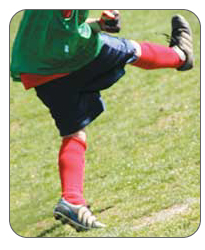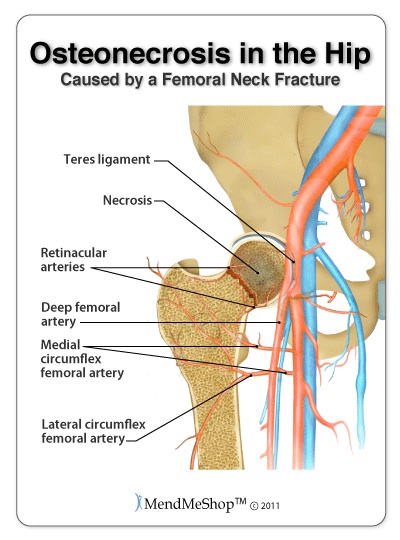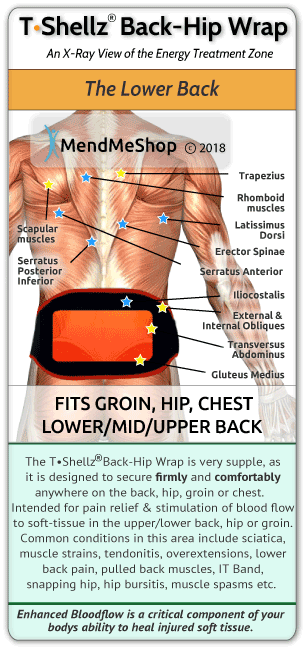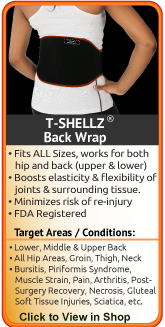|
|
Hip Flexor TendinopathyIliopsoas TendonitisYou hip is a complicated joint with 5 bones, 17 muscles, numerous tendons, ligaments and bursae connecting your leg bone (femur), pelvis and spine all together. The iliopsoas muscle is actually made up of two separate muscles located in front of the hip. These muscles and tendons connect the pelvis to large leg bone (femur), and are often called the 'hip flexors'. They help with movements of the hip and leg to to pull the knee upward, help us stand, sit and lay down. If you are suffering from hip flexor tendonitis (Iliopsoas Tendonitis) it might be hard to tell. Pain can easily be transferred to other areas of the hip, thigh, lower back or buttock. Sometimes pain can even shoot down the inside of your thigh or even down the front of your leg to your knee. If left untreated, hip flexor tendonitis can turn into a chronic condition or degeneration of your tendon fibers. Hip tendonitis (tendinitis) is a condition where you experience pain, swelling and inflammation from damage or micro-tearing of one or more of the tendons in your hip. The tendons in your hip connect muscle to bone and when these tendons are injured they usually cause pain and tenderness at the front, side and back of your hip, and even into your buttocks as well. Anyone can suffer from tendinitis, but it's most common in adults due to degeneration of tissue as we age. Over time the tendons in the hip will wear down resulting in something called degeneration. This is where the fibers in your tendons will become more weak - it's just a natural process that happens as we age. Symptoms of Iliopsoas TendinitisIf you have iliopsoas tendinitis you may experience pain and tenderness that slowly increases over time in the front of your hip and groin. Pain may increase after activities like jogging, running or kicking. As the condition progresses you may notice pain when putting on socks and shoes, rising from a seated position, walking upstairs or brisk walking. You may also notice radiating pain from the front of the thigh toward the knee. On occasion you may have lower back pain. Typically, the amount of time between first on-set symptoms and a proper diagnosis of iliopsoas tendonitis is approximately 32 to 41 months. Causes of Iliopsoas Tendinitis Hip tendonitis is an overuse / repetitive use injury of the hip area, resulting in damage or micro-tearing to the tendon tissue. The tendon becomes inflammation and swollen. Activities that may causes Hip tendonitis include:
How Is Iliopsoas Tendinitis Diagnosed?The best way to diagnose this condition is with a quick visit to the your doctor or physical therapist for a physical examination of your hip and groin area. A doctor or physical therapist may perform a Ludloff test, which requires you to sit with your knees extended and elevate your heel on the side you have pain. This movement of the hip and groin will help your doctor to see if you have any weakness around your hip flexor. They may also be able to see if you have any related hip injuries or conditions like snapping hip syndrome. An MRI may be ordered to pin-point the location of your tendonitis allowing you to know where you need to apply treatment for healing. Do You Really have Hip Tendonitis?Pain, swelling and inflammation in your hip could mean that you have hip tendonitis. It's also important to consider that there are other conditions that might cause pain in your hip as well. With so many connections of tissue to the bone it's easy to see why any pain in the hip can be tendonitis or some other injury in the same area. You may even have tendonitis AND another hip condition at the same time. The only way you can know for sure whether you have hip tendonitis is if you get a proper diagnosis for the condition by your doctor. Some other hip injuries include: hip tendonitis, snapping hip syndrome, greater trochanteric pain syndrome, hip arthritis, labral tear, osteonecrosis, or a fractured hip.  Hip Bursitis Inflammation and pain of the bursa sac in the hip joint. Pain and tenderness is found deep in your groin and radiates around to the front of your hip or upper thigh area, and can follow the length of the tendon down toward your knee; it will often move into your lower back and buttock area as well. Hip Bursitis common during growth spurts when you are younger because your biomechanics are altered around the hip area. The tendons and muscles area tight, the pelvis begins to tilt, and the rest of the lower body goes out of alignment. This can affect the lower back, hip joints, knees and your gait which can result in lower body joint issues. Crystal Deposits in the Joint - Rheumatoid arthritis or gout can cause iliopsis bursitis. Some people with diseases such as rheumatoid arthritis, gout or scleroderma may contract bursitis from crystalline deposits in the joints. Although not much is known about how this process happens, it is common knowledge that uric acid is a normal byproduct of daily metabolism. If you have gout, you are unable to break down this uric acid properly, leading to crystallization of this excess acid which deposits in joints. This can cause joint pain that can often lead to bursitis. Excessive Friction - Iliopsoas bursitis and iliopsoas tendonitis are often caused by excessive rubbing against a broad, shallow groove over which your iliacus and psoas major pass (the pubic iliopectineal eminence). The tendon may first become irritated and inflamed, leading to swelling and increase friction on the iliopsoas bursa underneath. Leg length discrepancies may result in a skewed gait (abnormalities in the way you walk) which can cause more pressure on the iliopsoas bursa than usual. In addition, age and degenerating tissues often causes a decrease in your tendon flexibility can change the movement in your hip joint, leading to excess friction on the tendon and bursa.  Snapping Hip Syndrome - Snapping hip syndrome is when you feel a snapping sensation or hear a popping sound in your hip when you walk, get up from a chair or swing you leg around. This feeling and/or sound is made by a tendon in your hip as it moves over a bony bump. Most of the time this is more annoying than painful. However long-term snapping/popping can lead to hip bursitis, a condition that is very painful. Greater Trochanteric Pain Syndrome - (GTPS) causes chronic pain on the side of the hip. Symptoms of GTPS include constant pain in the side hip that travels along the whole side of the thigh to the knee and occasionally below the knee and/or buttock. If you have this condition you will probably feel very specific point tenderness on the side of the hip. Hip Arthritis - Joint pain and can be described as a dull aching pain in the groin, outer thigh, or buttocks. You may feel more pain in the morning that could get worse as the day goes but generally lessens as you get more active. Doing anything vigorous can result in pain, stiffness and may limit your movements or make walking difficult. Arthritis means inflammation of a joint and there are a number of types of arthritis of the hip - including:
Labral Tear - The labrum is the cartilage that surrounds the hip joint. If you have a tear in your labrum you may feel a catching sensation and pain in the hip joint, groin, stiffness and limited range of motion of your hip. Any changes or abnormalities in the physical structure of the hip can lead to a tear in the labrum cartilage.  Osteonecrosis - A disease that affects blood flow to an area of bone. This lack of blood flow to the bone in the hip joint causes tissue to die and the bone may eventually collapse. Osteonecrosis is a condition that develops in stages, general hip pain is usually felt first that may progress to a dull ache or throbbing pain in the groin or buttock area. If you have this condition you may also have more pain and find it difficult to stand and put weight on you hip. Moving your hip joint will also be painful. These stages can last anywhere from several months to over a year. Early diagnosis of this disease provides a much better outcome with consistent, proper treatment. Fractured Hip - De-generative hip fractures are most common in elderly patients with osteoporosis. Treatment of broken hips requires surgery to either replace the broken portion or repair it with a metal plate and screws. Stress fractures of the hip are most common in athletes who participate in high-impact sports, such as long distance runners. Treatment is usually successful by avoiding the impact activities. How Do I Cure Iliopsoas Tendinitis?If you suspect you have tendonitis in your hip,
No one is immune to tendinitis, you can reduce your risk of re-injury with consistent conservative treatments If you have pain and inflammation in your hip, buttock and/or your tail bone, it's very important to heal your injury quickly and completely. You must avoid the build up of scar tissue. If you don't, your hip tendinitis injury may last for a very long time. This is why it's so important to continuously use conservative treatment tools to heal any recurring tendon damage before it can build into something big. For any hip tendinitis sufferer, having the right tools makes all the difference. In mild and moderate cases of tendinitis / strained tendons, your Physical Therapist will most likely encourage you to augment your sessions with conservative home treatments. Severe injury to the tendon (ruptured tendons) will require surgery to re-attach the tendon to your bone or bring the edges of the tear together. If you suspect that you've ruptured your tendon be sure to speak with your doctor for suggested treatment. Hip Flexor Tendonitis Home Conservative Treatment OptionsStep 1 - Reduce Pain and Swelling with Cold CompressionThe first step for conservative treatment of your hip tendinitis is to reduce the swelling to "open up" the area for more blood flow. Anyone in the health-care business knows that your blood supplies the oxygen and much needed nutrients required to heal hip tendinitis injuries. This is why for years, doctors, trainers, and other medical professionals have recommended RICE (Rest, Ice, Compression, Elevation) to treat the pain and swelling of fresh injuries, chronic pain, and after any re-injury. Cold Compression Slows nerve and tissue function - reducing the swelling that blocks blood vessels from doing their job. This is important because once blood vessels are blocked or damaged, they can no longer carry oxygenated blood through the tissue and tissues begin to break-down. Without cold compression, tissue break-down continues as they don't get the oxygen they need to survive. By limiting the amount of damage done to your tendon, you also limit the amount of healing that needs to occur. This is a very important step to heal tendon injuries faster and with less pain! This is why you need to treat your hip pain right after it's hurt, when you notice pain / swelling / inflammation, or directly after a re-injury. Applying a Cold Compress or Ice Pack right away will help stop the damage immediately and unblock your blood vessels to let your body's natural blood flow in to start healing the tissue. Use a Cold Compress or Ice Pack:
Step 2 - Improve Circulation, Soften Scar Tissue & Prevent Re-Injury with a TShellz Wrap®After the inflammation in your hip has been reduced, strengthening the area and applying a local circulatory stimulation device like the Back/Hip TShellz Wrap® is really what is needed for completing the recovery cycle. This is critical because blood flow is really how your body is able to heal itself. When the tendon tissue is damaged, the already-reduced blood flow is decreased down to a trickle which is why movement is encouraged - it helps get blood flow to where it is needed. Blood flow (healthy circulation) is an important part of natural tissue healing. Injured tendons take the nutrients available in local blood flow (like oxygen and healing agents) to get rid of any damaged tissue and start growing healthy tissue.  Increased Blood Circulation = Increased Healing CapabilityTShellz Wraps® contain a unique Carbon Fiber Energy Pad which is flexible and will shape to conform to your body. This Energy Pad emits a uniform wave of perfectly safe energy over its entire surface. This energy is absorbed by soft tissue in the treatment area, opening blood vessels, resulting in an increase in blood flow. Increased blood circulation is what your body needs to accelerate the healing of soft tissue and this is why we recommend the TShellz Wrap®. The TShellz Wrap® is an FDA Registered Medical Device and is suitable for use in therapeutic clinics and FROM HOME. It is completely safe for people and patients to use for themselves. The technology found in a TShellz Wrap® has been used for decades in the worlds of professional and amateur sports - a contributing factor as to why athletes seem to recover from injuries so quickly. Have you ever wondered by an athlete can return to activity after 3 or 4 weeks following a tendon injury - while your average person takes much longer to return back to normal? The secret isn't really that much of a secret - it involves consistent treatments (meaning multiple times a day) using a treatment like the TShellz Wrap® to stimulate blood flow to the injured tissues. Most athletes have the luxury of using in-house facilities many times per day. How many us can afford the time and money to visit a clinic multiple times a day? Very few indeed. This is how you can gain some of the advantages that athletes enjoy in their injury recovery - by using a device like the TShellz Wrap® two or three times a day on a consistent basis. Consistent Treatments = Consistent And Long Term ImprovementWhat Else Makes the TShellz Wrap® So Special?We believe the TShellz Wrap® to be one of the most effective home treatments to increase localized blood flow in and around the treatment area. We can promise that you will receive a product that is designed to be safe and does what it is supposed to do...quickly relieve pain and aid in the recovery from tendon, muscle and other soft tissue injuries. The unit plugs into a standard wall outlet to get its power. The nice thing about the power supply is that the same unit can be used in North America and overseas as well. It has the capability to operate between 110v and 230v. The TShellz Wrap® has a special signal controller that can be set for 3 different power levels of application (3=High, 2=Medium, 1=Low). The cord is long enough that you can sit or lie comfortably and watch TV, read or surf the net while you're using it. Treatments are max 30 minutes in duration and the device can be worn over clothing. This allows you to use the device at work, at home, or really anywhere you have access to an electrical outlet. Conservative Treatment Tools Our Clients Have Used to Help |
        |








